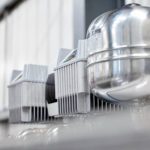What are the differences between expansion vessels and pressure vessels?
Have you ever wondered why expansion vessels come in all sorts of different colours, shapes and sizes, and why they’re even needed?
This blog will give you a brief guide on expansion vessels, pressure vessels and explain the differences between heating and potable water vessels.
The Scientific Bit
As water heats up in a sealed pressurised heating system the molecules within the water are energised and increase in activity. This will lead to the water expanding. The opposite is also true as water cools.
This can be easily demonstrated by taking a pot of water from room temperature to boiling point and back to room temperature again (or just go and get a brew!). Water expands by roughly 4% when taken from room temperature to 100 deg. C Why don’t we get steam in a sealed system? Well, that is a story for another day.
Expansion Vessels
What Are Expansion Vessels?
Expansion vessels vary in design, but an expansion vessel is a tank or cylinder that contains a diaphragm or membrane to manage and contain the expansion and contraction of fluid in a sealed system.
How Do Expansion Vessels Work?
These vessels have two parts. One part contains compressed air (or nitrogen) pre-charged to a certain pressure and the other part contains the pressurised water, with the diaphragm in between. As the water in the system expands and enters the expansion vessel, the air is compressed to absorb the added volume without causing over-pressurisation. The reason? Water cannot be compressed, but air or gas can be.
Importantly, it’s not just heating or hot water systems that require expansion. Chilled systems or cold water loops also need expansion. As the water cools down in these systems it’s important that the system pressure doesn’t drop as this can lead to the creation of a vacuum and/or cavitation. The vessel in this instance will then push pressurised water back into the system to maintain the system pressure.

Pressure Vessels
What Are Pressure Vessels?
Pressure vessels are the constructed in the same way and also act as expansion vessels, but serve a different purpose.
Although we are talking about the same product here (expansion vessels and pressure vessels) we would normally use the term ‘pressure’ vessel when describing the vessel used to ensure the smooth control of a pressure boosting system.
Pressure vessels are used to maintain the system pressure when the demand stops and no pumps are running, and to enable the easy start-up of both fixed and variable speed pumps.
In a residential cold water boosting application, for example, due to the number of different outlets both small and large, the pressure vessel on these applications is often sized to act as a storage facility and prevent the pumps switch on and off too frequently i.e. if there is only a very small demand, the system will just draw of the vessel for that purpose.
In applications where a fixed speed pump is used in conjunction with a pressure switch, the pressure vessel should be pre-charged with compressed air (or nitrogen) to 0.2 bar below the switch-on pressure of the pump.
Traditionally pressure vessels were used to control the frequency of the stop/start cycle of pumps on fixed speed booster sets, to prevent any one-pump overworking. As a result larger pressure vessels were used. These days with the majority of boosters using variable speed pumps, there is less of a need for larger vessels.
Pressure vessels are also used in a cold water pressure boosting systems to ensure that when there is no draw of water the system stays under pressure. If there is no pressure vessel on the system, or if the pressure vessel is pre-charged to a higher pressure than the running or switch-off pressure, the pump will re-start immediately when the pump starts. This can lead to a situation where the pumps ‘hunt’ (constantly switching on and off in quick succession) which causes premature motor and switchgear failure.
Potable Water Pressure Vessels
Potable water pressure vessels should be WRAS (or equivalent) approved for drinking water applications. As a result some of the materials of construction differ, often using stainless steel for metallic parts in contact with the water, and rubbers specifically suitable for contact with drinking water.
Remember, at tradepumps.com we are here to help you with everything pump-related, so please get in touch.
FREEPHONE 0808 250 0669
Check out our range of pressure vessels & expansion vessels available from UK stock, BUY Online today https://www.tradepumps.com/spares/expansion-vessels









